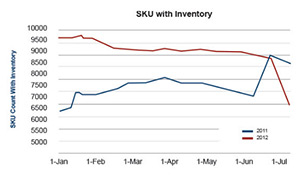
Measure Twice, Cut Once: Getting the Most Out of Your System Data
Marvin Logan | 23 October 2013
Analyzing the data (measurements) surrounding your operation will help you get the most out of your current system and plan for its future.
In junior high I’d taken a “Shop” class. Here I honed my love for building, creating and also learned a valuable life lesson along the way. While creating a seemingly simple chair, I’d cut a piece of wood and found one leg to be 3” too short. I had cut from the wrong end! My teacher had always told me to, “Measure twice and cut once”. I still find this adage helpful to this day, especially when working with new clients.
Often times, we’ll receive Request for Quotes or Proposals (RFQ/RFP) to bid on systems that have been designed or duplicated from existing facilities. The layouts have been proven out several years prior in other locations, so it is often assumed they will behave the same today. More often, the RFP design has been mocked up in CAD, and we’re then given only two to three weeks to design, price and submit the proposal. Both scenarios can have risky outcomes, in which neither takes a deep dive into the true core of a system: its measurements!
Data, or measurements, offers a true peek into the life of the system. How does it behave? How large is it? How quickly does “it move”? Most importantly, what does it look like? Gathering data is essential in answering these questions about your system. However, gathering data can sometimes be intimidating, so you may be asking:
- What type of data?
- How is it gathered?
- How is it helpful, and what are the benefits?
What types of data should I gather?

System data that should be captured will allow one to easily understand the details of: the SKUs (Stock Keeping Units) or pieces, associates and their KPIs (Key Performance Indicators) and the facility’s components (material handling equipment rates, utilization rates, etc.). This data typically consists of:
- Quantity of SKUs by family type
- Order history (one year preferably)
- Each, case and pallet quantities picked
- Number of lines picked by SKU
- Inventory locations/type
- Industry trends (forecasts)
- Financials
- Description of operations (receiving, put-away, manufacturing, picking, storage, shipping, etc.)
- Equipment rates (utilization percentages, production rates, etc.)

This is only a starting point on the types or amount of data you should have. The more the better. You can sift through what is applicable and what can be ignored.
How should I gather the information?
There are many sources and methods to gathering the data that you need. Many of you already have infrastructures in place to aid in this area. Others have to use different practices to search out and compile. If your facility has an ERP (Enterprise Resource Planning) or WMS (Warehouse Management System) in place, you can pull readily available information that should already be captured.
These types of systems help manage the inventory from receiving, through put-away and order fulfillment. ERP and WMS packages can have a lofty price tag and that leaves a lot of other companies without this luxury. Without these in place, nor a “home-grown” management system, you’ll have to compile data from your on-site resources. These will include the front office (or whoever handles order receiving/processing), time studies (i.e. manufacturing, order fulfillment rates, etc.), departmental historical data and talking with managerial staff, pickers/operators and maintenance. This, no doubt, will take extra time and effort, but is well worth the investment.
Now that I have the data, how does this help?

Searching and studying your information allows you to plan for your future. It can show what the next logical step is at your facility. Should you expand, re-slot your SKUs and MANY other questions will arise from your data discoveries.
At this point, you should have all the stakeholders involved and wrap your heads around how to move forward. If you are looking into material handling equipment, you’ll now be able to understand how to size buffers, picking solutions or how simplistic/advanced your tech should be.
If this isn’t an area in which you feel comfortable, there are many consulting services that can aid your team on how to design, size and implement new processes. An Engineering Analysis can:
- Create a manageable, phased action plan tailored to your business requirements and goals
- Aid in the selection of the proper solution based on data-driven analysis and business objectives
- Provide quantitative data to justify system changes and/or upgrades
- Predict required investment as well as payback period and ROI
- Guarantee improvement in system and labor efficiency
If you choose to implement a layout or design without looking at the system’s measurements, you could end up with systemic bottlenecking, late shipments, errors on picks and other critical issues that can easily be avoided. Understanding the historical data lends itself to lucrative decisions and a successful business model. Always remember to “measure twice and cut once”!
Marvin Logan is the Vice President of Consulting and Integration at Bastian Solutions. After graduating from Purdue University, Marvin started his career as an industrial engineer and quickly moved into management. He has had roles as a distribution system manager, operations manager, director of engineering, director of distribution, and vice president of distribution for several leading companies.
Comments
No comments have been posted to this Blog Post
Leave a Reply
Your email address will not be published.
Comment
Thank you for your comment.